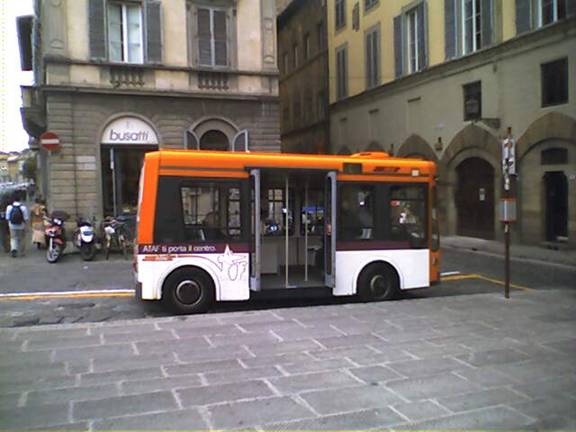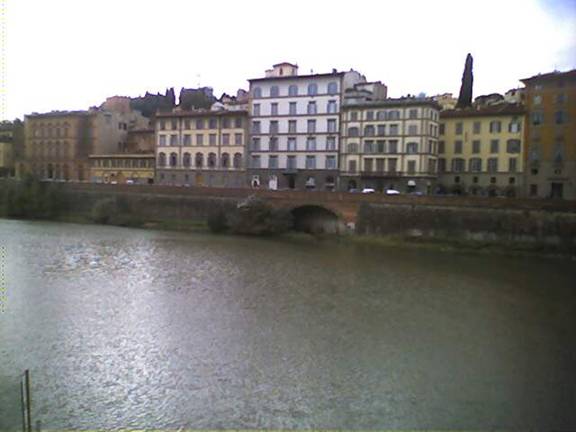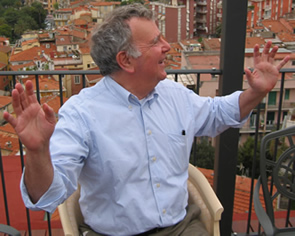Day 14: Florence
Our last day in Florence…..and the sun is shining. Our first stop is another less well known attraction, the Chiostro del Scalzo, which contains a monochrome (grisaille) fresco by Andrea del Sarto and his students; del Sarto also did the Last Supper we had seen at San Salvi earlier in the week. It is a few blocks away from San Marco, so we walk outside the apartment and find our little “C” bus waiting for us.

When we arrive at the cloister, there is only one other person there; she is sitting on a bench taking notes. The frescoes cover all four walls of the small courtyard, which is covered by a glass roof. The scenes are from the life of St. John the Baptist and begin with his birth and end with the scene of his head being presented to Herod and his wife. The monochrome effect gives the frescoes more a feeling of drawings—and these are very good drawings. The details are strikingly drawn, whether the hands and feet, robes, faces or the landscapes in the background….and we appreciate having the time and the space to take it all in.
Before we leave, several more visitors arrive—including a class of Italian high school students, notebooks in hand.
We move from the somewhat obscure to one of the most influential and frequently visited frescoes in Florence….the Masolino and Masaccio works in the Brancacci Chapel at Santa Maria del Carmine. These colorful frescoes are said to be a major turning point in art and one of the key developments that influenced the culture of the Renaissance. At the Brancacci Chapel, you have to share the small space with a couple of dozen other viewers…sometimes having to jockey for a better position to see the panels.
There are two small contrasting works—one by Masaccio, one by Masolino—showing the expulsion from the Garden of Eden but the rest of the panels portray scenes from the life of St. Peter. In his work, Masaccio is considered to be the first to show scenes that are from real life….showing “textures” of the real world, demonstrating his understanding of perspective and painting scenes full of drama. The two panels of the expulsion show the difference….Masolino paints formal portraits of Adam and Eve whereas Masaccio shows the couple full of pain and shame as they are banished from Eden. In addition to illustrating the incidents in the life of St. Peter, Massacio also gives the painted figures individuality and shows what they are thinking as well as providing us with details about 15th century Florentine life in the clothes and settings he creates.
After we leave the chapel, we stay for a film that is showing about Masaccio, the frescoes and his influence. Some of the film is quite creative…moving from computer generated scenes of Florence in the 14th century to actual film images of the same scenes today. The comparison of the frescoes to other art works is helpful to us and the camera panning in to reveal the minute details of the works is worth seeing….but all in all, the film is pretty heavy going.
After the film is over, we look at some of the art works displayed in the same room and find another Last Supper, this one by Allori, which had not been written about in any of our books.
On the way back to the apartment, we stop and buy four bottles of olive oil to take home with us. We stop at a sandwich shop we’ve passed many times and eat our lunch, sitting on the steps of Santo Spirito.
After dropping off our purchases and resting for a bit, we go to see the Boboli Gardens; we have never been there. The gardens are bigger than I had imagined and there is an impressive steeply terraced hillside leading up to the top. We decide to skirt the hill and take a path that leads past the Botanical Gardens, lots of Roman statuary and thickly planted woods. We stroll down the cypress-lined main path to the Isolotto, a small lake with an island in the middle decorated with statues and a fountain. We don’t want to have to head back up the hill so we try to exit at the closest gate—the Porta Romana—but it is locked. We start walking back to and are able to slip out through the Annalena Gate. I can’t say that we were very enchanted by the gardens….but it is certainly an impressive undertaking.
I have an appointment at the Palazzo Antellesi to see some of the apartments that they have available….I had put a client there just two weeks before. The Palazzo is a heavily decorated old building from the 1500s situated on the south side of Piazza Santa Croce. It is owned by the Piccolomini family, who are descended from one of the noble families of the Renaissance. We meet the owners and we are taken around by Vicky, the staff person that I usually contact.
The apartments are amazing…large rooms, some with original frescoes on the walls, some with antique furniture, all well equipped. One of them has two large bedrooms and the living room with large windows overlooking the piazza, another (on the top floor) has a skylight so it is very bright and cheerful. Two of them have terraces overlooking the piazza. They are not cheap, but they appear to be comfortable and luxurious. Certainly if money is no object, these apartments are good choices. It is very helpful for me to have seen them personally when I suggest them to clients.
We decide to go to the Trattoria Cibreo for our last meal in Florence. The very informal trattoria shares a kitchen with the more expensive restaurant and serves some of the same dishes. They don’t take reservations and we were afraid that we would have to wait for a table but we get in immediately. Our table is a small one and one of the chairs is in front of the door to the wine cellar, so several times during the meal Diana has to get up to let a waiter go downstairs to get some wine.
Dinner is fun although they don’t serve pasta and the menu has many somewhat unusual options- e.g. stuffed chicken neck with the head attached. Diana doesn’t go for the strange options – she has crostini with liver pate, yellow pepper soup, and eggplant parmesan—which are all good-especially the yellow pepper soup. I have a very tender, fresh tripe salad, a dish of polenta with parmigiano and herbs (great) and a stew made with calves feet (zampa) which was rich and very flavorful. I have the panna cotta (pretty good) and Diana’s chocolate cake is good but very rich. The waiter brings us a third dessert…cheesecake. We think he has heard us trying to decide between the cheesecake and the chocolate cake…the cheesecake is excellent. We have another nice wine from the Maremma…a Morellino del Scansano—Poggio Il Lupo 2003 from the Tenuta Sette Ponte. All this food comes to Euro 75.00….a feast. Actually the portions are small which encourages diners to sample all the courses. The antipasti and primi are all Euro 5 and the secondi are all Euro 13.00. The service is friendly and professional…as it usually is in Italian restaurants.
When we are about ready to leave, a tremendous thunderstorm begins and the waiter says that taxis are impossible to get. We run over to the Caffe Cibreo, their bar around the corner, to wait out the rain and try to get a cab. The waitress tells us that the cab company said it would take an hour for one to come but after less than ten minutes, a cab pulls up and we grab it. We are quickly back in the apartment for our last night in Florence.
PS Here is a picture of our apartment building, the Palazzo Bardi, taken from the Uffizi….our building is the tallest in the set of three—painted white--in the middle of the picture, just over the opening (like a tunnel) at river level.


When we arrive at the cloister, there is only one other person there; she is sitting on a bench taking notes. The frescoes cover all four walls of the small courtyard, which is covered by a glass roof. The scenes are from the life of St. John the Baptist and begin with his birth and end with the scene of his head being presented to Herod and his wife. The monochrome effect gives the frescoes more a feeling of drawings—and these are very good drawings. The details are strikingly drawn, whether the hands and feet, robes, faces or the landscapes in the background….and we appreciate having the time and the space to take it all in.
Before we leave, several more visitors arrive—including a class of Italian high school students, notebooks in hand.
We move from the somewhat obscure to one of the most influential and frequently visited frescoes in Florence….the Masolino and Masaccio works in the Brancacci Chapel at Santa Maria del Carmine. These colorful frescoes are said to be a major turning point in art and one of the key developments that influenced the culture of the Renaissance. At the Brancacci Chapel, you have to share the small space with a couple of dozen other viewers…sometimes having to jockey for a better position to see the panels.
There are two small contrasting works—one by Masaccio, one by Masolino—showing the expulsion from the Garden of Eden but the rest of the panels portray scenes from the life of St. Peter. In his work, Masaccio is considered to be the first to show scenes that are from real life….showing “textures” of the real world, demonstrating his understanding of perspective and painting scenes full of drama. The two panels of the expulsion show the difference….Masolino paints formal portraits of Adam and Eve whereas Masaccio shows the couple full of pain and shame as they are banished from Eden. In addition to illustrating the incidents in the life of St. Peter, Massacio also gives the painted figures individuality and shows what they are thinking as well as providing us with details about 15th century Florentine life in the clothes and settings he creates.
After we leave the chapel, we stay for a film that is showing about Masaccio, the frescoes and his influence. Some of the film is quite creative…moving from computer generated scenes of Florence in the 14th century to actual film images of the same scenes today. The comparison of the frescoes to other art works is helpful to us and the camera panning in to reveal the minute details of the works is worth seeing….but all in all, the film is pretty heavy going.
After the film is over, we look at some of the art works displayed in the same room and find another Last Supper, this one by Allori, which had not been written about in any of our books.
On the way back to the apartment, we stop and buy four bottles of olive oil to take home with us. We stop at a sandwich shop we’ve passed many times and eat our lunch, sitting on the steps of Santo Spirito.
After dropping off our purchases and resting for a bit, we go to see the Boboli Gardens; we have never been there. The gardens are bigger than I had imagined and there is an impressive steeply terraced hillside leading up to the top. We decide to skirt the hill and take a path that leads past the Botanical Gardens, lots of Roman statuary and thickly planted woods. We stroll down the cypress-lined main path to the Isolotto, a small lake with an island in the middle decorated with statues and a fountain. We don’t want to have to head back up the hill so we try to exit at the closest gate—the Porta Romana—but it is locked. We start walking back to and are able to slip out through the Annalena Gate. I can’t say that we were very enchanted by the gardens….but it is certainly an impressive undertaking.
I have an appointment at the Palazzo Antellesi to see some of the apartments that they have available….I had put a client there just two weeks before. The Palazzo is a heavily decorated old building from the 1500s situated on the south side of Piazza Santa Croce. It is owned by the Piccolomini family, who are descended from one of the noble families of the Renaissance. We meet the owners and we are taken around by Vicky, the staff person that I usually contact.
The apartments are amazing…large rooms, some with original frescoes on the walls, some with antique furniture, all well equipped. One of them has two large bedrooms and the living room with large windows overlooking the piazza, another (on the top floor) has a skylight so it is very bright and cheerful. Two of them have terraces overlooking the piazza. They are not cheap, but they appear to be comfortable and luxurious. Certainly if money is no object, these apartments are good choices. It is very helpful for me to have seen them personally when I suggest them to clients.
We decide to go to the Trattoria Cibreo for our last meal in Florence. The very informal trattoria shares a kitchen with the more expensive restaurant and serves some of the same dishes. They don’t take reservations and we were afraid that we would have to wait for a table but we get in immediately. Our table is a small one and one of the chairs is in front of the door to the wine cellar, so several times during the meal Diana has to get up to let a waiter go downstairs to get some wine.
Dinner is fun although they don’t serve pasta and the menu has many somewhat unusual options- e.g. stuffed chicken neck with the head attached. Diana doesn’t go for the strange options – she has crostini with liver pate, yellow pepper soup, and eggplant parmesan—which are all good-especially the yellow pepper soup. I have a very tender, fresh tripe salad, a dish of polenta with parmigiano and herbs (great) and a stew made with calves feet (zampa) which was rich and very flavorful. I have the panna cotta (pretty good) and Diana’s chocolate cake is good but very rich. The waiter brings us a third dessert…cheesecake. We think he has heard us trying to decide between the cheesecake and the chocolate cake…the cheesecake is excellent. We have another nice wine from the Maremma…a Morellino del Scansano—Poggio Il Lupo 2003 from the Tenuta Sette Ponte. All this food comes to Euro 75.00….a feast. Actually the portions are small which encourages diners to sample all the courses. The antipasti and primi are all Euro 5 and the secondi are all Euro 13.00. The service is friendly and professional…as it usually is in Italian restaurants.
When we are about ready to leave, a tremendous thunderstorm begins and the waiter says that taxis are impossible to get. We run over to the Caffe Cibreo, their bar around the corner, to wait out the rain and try to get a cab. The waitress tells us that the cab company said it would take an hour for one to come but after less than ten minutes, a cab pulls up and we grab it. We are quickly back in the apartment for our last night in Florence.
PS Here is a picture of our apartment building, the Palazzo Bardi, taken from the Uffizi….our building is the tallest in the set of three—painted white--in the middle of the picture, just over the opening (like a tunnel) at river level.



0 Comments:
Post a Comment
<< Home